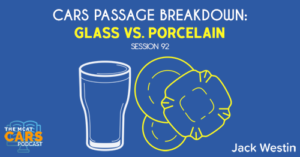Apple Podcasts | Google Podcasts
Session 92:
Come explore another article to understand the author’s views as they write about why glass is so popular. As always, I’m joined by Jack Westin from JackWestin.com. Again, Jack recommends reading the passage before actually listening to the episode. Come up with your own conclusions, your own thoughts. on what the author is trying to tell you and then listen along and see if you got it right or wrong.
Check out Jack Westin and all their amazing free resources including a free trial session of Jack’s full course to see how it’s like learning from Jack Westin himself.
Listen to this podcast episode with the player above, or keep reading for the highlights and takeaway points.
Link to the article:
https://www.bbc.com/culture/article/20200714-why-glamorous-glassware-is-booming
“Glass is often the poor relation to ceramics,” says Mark Hill, glass collector, author of several books on 20th-Century glass and a specialist on the BBC’s Antiques Roadshow. But, asked why this is the case, Hill is mystified: “I can’t think of an explanation. Somehow glass is secondary to ceramics in terms of the volume of books and articles written and its value in broad-brush terms. An antique porcelain bowl is often worth more than a contemporaneous glass piece.”
Yet the popularity of glassware endures. Particularly sought-after is experimental, modernist glass produced from the 1930s to the 1970s in Murano just north of Venice, along with glassware from Sweden, Finland, Denmark, the UK, the US and Czechoslovakia. Its appeal has persisted thanks to the broad spectrum of styles produced during the postwar era. There’s a world of difference between Murano’s flamboyant confections that harnessed ancient decorative techniques such as murrine (coloured patterns visible in glass canes cut in cross-section) to create wildly kaleidoscopic, abstract patterns, and the more restrained work of Finnish designers. The Finns favoured modernist simplicity – bold, pared-down forms – and muted, nature-inspired colours.
A classic example of modernist Finnish glass is the ever-popular Savoy vase of 1936, a collaboration between husband and wife Alvar and Aino Aalto, whose approach to glassmaking was unorthodox. The prototype for this was created by blowing molten glass into an irregularly contoured hollow in the ground, which would ultimately determine the vase’s wavy, organic outline. It was later manufactured by Finnish glassworks Iittala in wooden moulds that were slowly burned away, and the finished, polished product graced Helsinki’s glamorous new restaurant, Savoy, whose interior was designed by the Aaltos in 1937. It has recently been refurbished by interior designer Ilse Crawford in conjunction, appropriately, with Artek, the Finnish homeware brand founded by the Finnish couple in the 1930s. In contrast to the Savoy vase’s smooth surface are the rugged textures of fellow Finn Timo Sarpaneva’s equally iconic Finlandia glassware of 1964 for Iittala. This is created by pouring molten glass into moulds with bark-like textures.
Some mid-century designers encouraged the cross-pollination of ideas between countries. In the UK, Geoffrey Baxter, who worked for British, forward-looking handmade glass manufacturer Whitefriars Glass from 1954 to 1980, was heavily inspired by Scandinavian design. His late 1960s pieces, such as his wobbly-looking Drunken Bricklayer vase, available in a multitude of colours, featured roughly textured surfaces that recall Sarpaneva’s creations. Baxter played with tree bark, gouged wood, copper wire and tin tacks to achieve their appealingly knobbly surfaces.
Glassmaking in the 20th Century was further enriched by the international studio-glass movement, pioneered in the early 1960s by US glass artists Harvey Littleton, Dominick Labino and others. Their goal was to enable designers to produce glass pieces in a small furnace independently; previously most art glass was made in factories by teams of workers or individual glassblowers operating in large, shared buildings. The immediacy of this new approach resulted in highly expressive pieces.
[02:11] Architecture Passage
Many of my students have trouble with architecture passages these kinds of passages are very specific. They’re very detailed on a topic most students are not necessarily interested in. They zone out completely, especially when it gets into descriptions of the buildings or whatever they’re discussing. This is a good practice run for a future architecture or art passage that you may get on the actual test.
“Learn how to stay focused and find trends in what they're discussing. Learn to figure out why they're discussing what they're discussing.”Click To Tweet[03:50] Paragraph 1, Sentence 1
“Glass is often the poor relation to ceramics,” says Mark Hill, glass collector, author of several books on 20th-Century glass and a specialist on the BBC’s Antiques Roadshow.
Jack says:
We’re given the name of this glass collector and author of books. The author is painting him as a specialist. And this expert is saying that glass is often the poor relation to ceramics. It probably means that glass is inferior to ceramics. But we’ll see what the author/expert exactly means by this, or, in this case, Mark Hill.
As long as you know we’re discussing glass and ceramics, you’re going to be fine. And obviously, there is a difference between the two. So you should find the distinction between gloss and ceramics.
[04:59] Paragraph 1, Sentence 2
But, asked why this is the case, Hill is mystified: “I can’t think of an explanation.
Jack says:
This is how Mark Hill believes glass appears to other people compared to ceramics but now we’re questioning why it may be inferior. It’s not necessarily as popular.
[05:43] Paragraph 1, Sentence 3
Somehow glass is secondary to ceramics in terms of the volume of books and articles written and its value in broad-brush terms.
Jack says:
Volumes of books written means basically it’s not as important. It’s not as popular. So it’s very similar to the first sentence. It has a poor relation and it’s not necessarily as strong as ceramics. Again, we’re questioning why this is happening.
It’s not bad to make that kind of assumption that glass is inferior as long as you’re willing to change it when you read in new information. The human mind is really interesting because it tries to predict or generalize information based on previous knowledge.
'Good readers try to predict where the author is going but when they see new information that completely challenges what they believe, they’re willing to adapt to this new information.”Click To Tweet[07:28] Paragraph 1, Sentence 4
An antique porcelain bowl is often worth more than a contemporaneous glass piece.”
Jack says:
You can look at it any way you want. You just know that glass isn’t necessarily as important or as valuable or it is inferior to ceramics. That’s where the author is going with this.
[08:08] Paragraph 2, Sentence 1
Yet the popularity of glassware endures.
Jack says:
It’s still popular just maybe not as popular as ceramics.
[08:37] Paragraph 2, Sentence 2
Particularly sought-after is experimental, modernist glass produced from the 1930s to the 1970s in Murano just north of Venice, along with glassware from Sweden, Finland, Denmark, the UK, the US and Czechoslovakia.
Jack says:
You may not know exactly where these cities or countries are, but just visualize them and associate them with glass. Because they may come up again. You will need to know that these countries or cities were using glass and had lost a vital part of their city. Or the way they look at glass is important to them.
[09:34] Paragraph 2, Sentence 3
Its appeal has persisted thanks to the broad spectrum of styles produced during the postwar era.
Jack says:
The author here is talking about why the popularity endures and just the broad spectrum of styles.
[09:53] Paragraph 2, Sentence 4
There’s a world of difference between Murano’s flamboyant confections that harnessed ancient decorative techniques such as murrine (coloured patterns visible in glass canes cut in cross-section) to create wildly kaleidoscopic, abstract patterns, and the more restrained work of Finnish designers.
Jack says:
These are evidence to support the fact that glass is popular and there are different styles. But the MCAT is very particular when it comes to architecture passages. In this case, it’s not necessarily architecture, but some sort of art. They like to test you on this evidence and on these examples. They want to make sure you actually know the difference between, let’s say, a Murano’s flamboyant confections and restrained Finnish.
This is where students start zoning out. They’ll just shut down mentally because they’re not used to reading colored patterns visible on glass canes. What does that mean? But if you read it slow enough, you can actually see what the author sees. You can actually interpret it in the author’s way.
[12:50] Paragraph 2, Sentence 5
The Finns favoured modernist simplicity – bold, pared-down forms – and muted, nature-inspired colours.
Jack says:
They’re an example of that more restrained work from the Finnish designers. The MCAT could ask which do you think the author would prefer is more flamboyant. And many times you have students who have no idea what is flamboyant. And you’ll have to pick something that resonates with what the author believes is flamboyant.
'The key is to make sure you're paying attention. Make sure your focus. Focus and discipline are the most important skills for CARS.'Click To Tweet[13:52] Paragraph 3, Sentence 1
A classic example of modernist Finnish glass is the ever-popular Savoy vase of 1936, a collaboration between husband and wife Alvar and Aino Aalto, whose approach to glassmaking was unorthodox.
Jack says:
We’re given another example of a modernist finishing glass vase and the people who made it. Just try to visualize this and see what this is. In this case, there aren’t that many descriptions of it because it’s just more historical.
[14:34] Paragraph 3, Sentence 2
The prototype for this was created by blowing molten glass into an irregularly contoured hollow in the ground, which would ultimately determine the vase’s wavy, organic outline.
Jack says:
Just try to picture those glass blowing videos on YouTube.
[14:59] Paragraph 3, Sentence 3
It was later manufactured by Finnish glassworks Iittala in wooden moulds that were slowly burned away, and the finished, polished product graced Helsinki’s glamorous new restaurant, Savoy, whose interior was designed by the Aaltos in 1937.
Jack says:
Again, just picture all of this glasswork in this restaurant. This is all visualization and it’s very intimidating. Because imagine you’re a premed student who spent two to three years studying science stuff. Then all of a sudden, you have to sit in a random test center, reading about vases and different styles. It’s the last thing that a premed student would expect to be on their exam. It teaches us a very valuable lesson of paying attention even if you think that the material is mundane or not interesting.
“It's really critical as a student that you can figure things out that you may not be familiar with.”Click To Tweet[16:24] Paragraph 3, Sentences 4-5
It has recently been refurbished by interior designer Ilse Crawford in conjunction, appropriately, with Artek, the Finnish homeware brand founded by the Finnish couple in the 1930s. In contrast to the Savoy vase’s smooth surface are the rugged textures of fellow Finn Timo Sarpaneva’s equally iconic Finlandia glassware of 1964 for Iittala.
Jack says:
They’re examples of a Finnish designer and the different glassware they made. You’ve got to visualize this very embroidery technique. It’s not just smooth or wavy but it’s also rugged. They’re both associated with Finnish glasswork.
[17:17] Paragraph 3, Sentence 6
This is created by pouring molten glass into moulds with bark-like textures.
Jack says:
This paragraph has a lot of crazy stuff happening but not as crazy as the kaleidoscope. So you have to see that as a distinction.
Not all Finnish designers are doing the same thing of smooth and rugged. 50% of the population will just read through this and not catch onto those things. And those are the things that will make or break your score.
Knowing that Murano’s flamboyant confections are totally different than the Finnish vases, which could be rugged or wavy.
“Knowing there is a distinction, the difference there, and being able to visualize that is everything.”Click To Tweet[18:47] Paragraph 4, Sentence 1
Some mid-century designers encouraged the cross-pollination of ideas between countries.
Jack says:
This is a new concept that we can actually combine the ideas of different countries when it comes to glass. Starting off, every country was a little bit different. And now this new concept of mixed ideas.
[19:26] Paragraph 4, Sentence 2
In the UK, Geoffrey Baxter, who worked for British, forward-looking handmade glass manufacturer Whitefriars Glass from 1954 to 1980, was heavily inspired by Scandinavian design.
Jack says:
This is an example of someone who works at a glassmaker in the UK who was inspired by Scandinavian design.
[19:55] Paragraph 4, Sentence 3
His late 1960s pieces, such as his wobbly-looking Drunken Bricklayer vase, available in a multitude of colours, featured roughly textured surfaces that recall Sarpaneva’s creations.
Jack says:
It’s another example that ties into this previous designer that we were told about in the previous paragraph Sarpaneva.
[20:25] Paragraph 4, Sentence 4
Baxter played with tree bark, gouged wood, copper wire and tin tacks to achieve their appealingly knobbly surfaces.
Jack says:
Again, just visualize what this potentially looks like and how much fun it was to make it probably.
[20:49] Paragraph 5, Sentence 1
Glassmaking in the 20th Century was further enriched by the international studio-glass movement, pioneered in the early 1960s by US glass artists Harvey Littleton, Dominick Labino and others.
Jack says:
It’s talking more about the progress of glassmaking and how it was changed and by who?
[21:17] Paragraph 5, Sentences 2
Their goal was to enable designers to produce glass pieces in a small furnace independently; previously most art glass was made in factories by teams of workers or individual glassblowers operating in large, shared buildings. The immediacy of this new approach resulted in highly expressive pieces.
Jack says:
It’s further giving an example of what this international studio glass movement looked like. The key is knowing that we went from these teams to a more independent kind of furnaces.
[21:56] Paragraph 5, Sentences 3
The immediacy of this new approach resulted in highly expressive pieces.
Jack says:
The key for students is knowing there’s a dichotomy. Know that even though we’re discussing the realm of glass, there are different types of glass being created. In this case, you have the Murano, which is more flamboyant. And then you have the Finnish, which is more simplistic. It has its own kind of style. But then you also have the cross-pollination and then the author goes on and talks about how they’re trying to adapt or advance the field in some ways by making it even more independent, more expressive.
So there are a lot of things going on that they could test you on. Just be aware of what’s going on, what’s being said, and why it’s being said. Those are really important things that every student needs to know when they read CARS passages.
[22:21] Main Idea
It’s a little bit of the history of how glassmaking has evolved and changed over time and that it’s popular. Even though it might not be as popular as ceramics, the author is making a bold claim that glass is still popular. There are still different styles in different countries.
If a student just read the first paragraph, they may think the whole point of the passage is that ceramics is better than glass. But ceramics had nothing to do with this passage.
The first paragraph was more of an introduction. And the author would do such a thing just to make it clear that glass is still roaming around. It’s still popular. It’s still something that people do and did back in the day.
Links:
Link to the article:
https://www.bbc.com/culture/article/20200714-why-glamorous-glassware-is-booming
SEARCH SITE
SEARCH SITE
LISTEN FOR FREE












